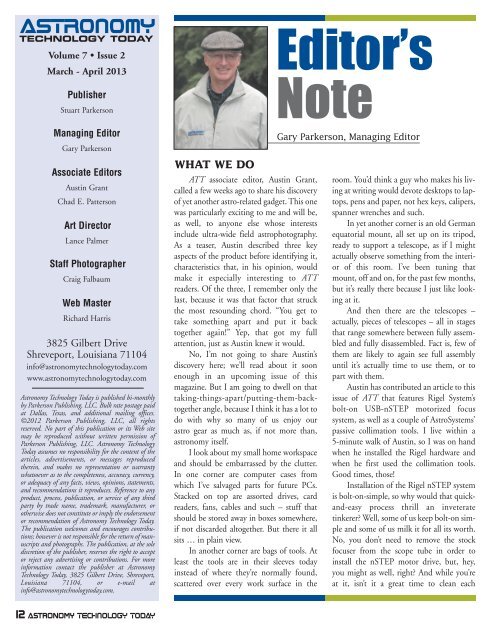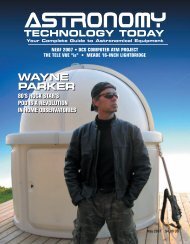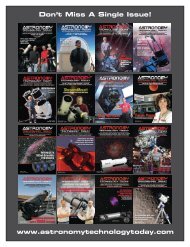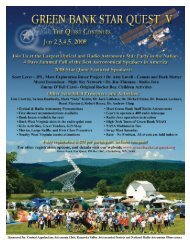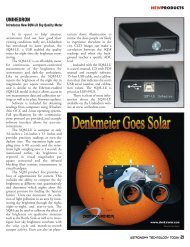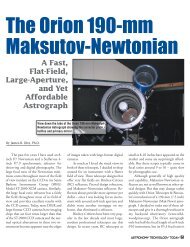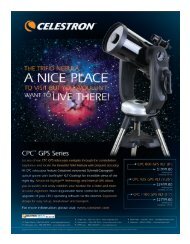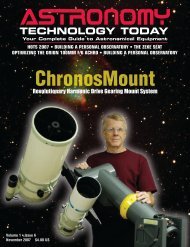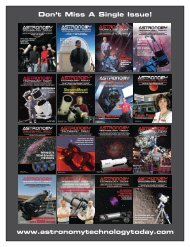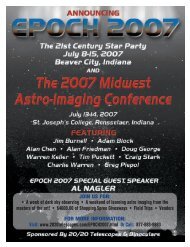iOPTRON - Astronomy Technology Today
iOPTRON - Astronomy Technology Today
iOPTRON - Astronomy Technology Today
You also want an ePaper? Increase the reach of your titles
YUMPU automatically turns print PDFs into web optimized ePapers that Google loves.
ASTRONOMY<br />
TECHNOLOGY TODAY<br />
Volume 7 • Issue 2<br />
March - April 2013<br />
Publisher<br />
Stuart Parkerson<br />
Managing Editor<br />
Gary Parkerson<br />
Associate Editors<br />
Austin Grant<br />
Chad E. Patterson<br />
Art Director<br />
Lance Palmer<br />
Staff Photographer<br />
Craig Falbaum<br />
Web Master<br />
Richard Harris<br />
3825 Gilbert Drive<br />
Shreveport, Louisiana 71104<br />
info@astronomytechnologytoday.com<br />
www.astronomytechnologytoday.com<br />
<strong>Astronomy</strong> <strong>Technology</strong> <strong>Today</strong> is published bi-monthly<br />
by Parkerson Publishing, LLC. Bulk rate postage paid<br />
at Dallas, Texas, and additional mailing offices.<br />
©2012 Parkerson Publishing, LLC, all rights<br />
reserved. No part of this publication or its Web site<br />
may be reproduced without written permission of<br />
Parkerson Publishing, LLC. <strong>Astronomy</strong> <strong>Technology</strong><br />
<strong>Today</strong> assumes no responsibility for the content of the<br />
articles, advertisements, or messages reproduced<br />
therein, and makes no representation or warranty<br />
whatsoever as to the completeness, accuracy, currency,<br />
or adequacy of any facts, views, opinions, statements,<br />
and recommendations it reproduces. Reference to any<br />
product, process, publication, or service of any third<br />
party by trade name, trademark, manufacturer, or<br />
otherwise does not constitute or imply the endorsement<br />
or recommendation of <strong>Astronomy</strong> <strong>Technology</strong> <strong>Today</strong>.<br />
The publication welcomes and encourages contributions;<br />
however is not responsible for the return of manuscripts<br />
and photographs. The publication, at the sole<br />
discretion of the publisher, reserves the right to accept<br />
or reject any advertising or contributions. For more<br />
information contact the publisher at <strong>Astronomy</strong><br />
<strong>Technology</strong> <strong>Today</strong>, 3825 Gilbert Drive, Shreveport,<br />
Louisiana 71104, or e-mail at<br />
info@astronomytechnologytoday.com.<br />
WHAT WE DO<br />
ATT associate editor, Austin Grant,<br />
called a few weeks ago to share his discovery<br />
of yet another astro-related gadget. This one<br />
was particularly exciting to me and will be,<br />
as well, to anyone else whose interests<br />
include ultra-wide field astrophotography.<br />
As a teaser, Austin described three key<br />
aspects of the product before identifying it,<br />
characteristics that, in his opinion, would<br />
make it especially interesting to ATT<br />
readers. Of the three, I remember only the<br />
last, because it was that factor that struck<br />
the most resounding chord. “You get to<br />
take something apart and put it back<br />
together again!” Yep, that got my full<br />
attention, just as Austin knew it would.<br />
No, I’m not going to share Austin’s<br />
discovery here; we’ll read about it soon<br />
enough in an upcoming issue of this<br />
magazine. But I am going to dwell on that<br />
taking-things-apart/putting-them-backtogether<br />
angle, because I think it has a lot to<br />
do with why so many of us enjoy our<br />
astro gear as much as, if not more than,<br />
astronomy itself.<br />
I look about my small home workspace<br />
and should be embarrassed by the clutter.<br />
In one corner are computer cases from<br />
which I’ve salvaged parts for future PCs.<br />
Stacked on top are assorted drives, card<br />
readers, fans, cables and such – stuff that<br />
should be stored away in boxes somewhere,<br />
if not discarded altogether. But there it all<br />
sits … in plain view.<br />
In another corner are bags of tools. At<br />
least the tools are in their sleeves today<br />
instead of where they’re normally found,<br />
scattered over every work surface in the<br />
Editor’s<br />
Note<br />
Gary Parkerson, Managing Editor<br />
room. You’d think a guy who makes his living<br />
at writing would devote desktops to laptops,<br />
pens and paper, not hex keys, calipers,<br />
spanner wrenches and such.<br />
In yet another corner is an old German<br />
equatorial mount, all set up on its tripod,<br />
ready to support a telescope, as if I might<br />
actually observe something from the interior<br />
of this room. I’ve been tuning that<br />
mount, off and on, for the past few months,<br />
but it’s really there because I just like looking<br />
at it.<br />
And then there are the telescopes –<br />
actually, pieces of telescopes – all in stages<br />
that range somewhere between fully assembled<br />
and fully disassembled. Fact is, few of<br />
them are likely to again see full assembly<br />
until it’s actually time to use them, or to<br />
part with them.<br />
Austin has contributed an article to this<br />
issue of ATT that features Rigel System’s<br />
bolt-on USB-nSTEP motorized focus<br />
system, as well as a couple of AstroSystems’<br />
passive collimation tools. I live within a<br />
5-minute walk of Austin, so I was on hand<br />
when he installed the Rigel hardware and<br />
when he first used the collimation tools.<br />
Good times, those!<br />
Installation of the Rigel nSTEP system<br />
is bolt-on-simple, so why would that quickand-easy<br />
process thrill an inveterate<br />
tinkerer? Well, some of us keep bolt-on simple<br />
and some of us milk it for all its worth.<br />
No, you don’t need to remove the stock<br />
focuser from the scope tube in order to<br />
install the nSTEP motor drive, but, hey,<br />
you might as well, right? And while you’re<br />
at it, isn’t it a great time to clean each<br />
12 <strong>Astronomy</strong> TECHNOLOGY TODAY


